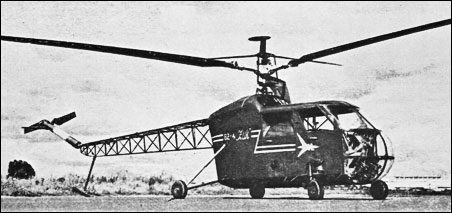
| PZL-Swidnik BZ-4 "Zuk" 1957 |  |
 |

| PZL-Swidnik BZ-4 "Zuk" 1957 |  |
 |
|
First displayed in the Polish Aviation Day Exhibition in August, 1956, the first prototype of the BZ-4 Zuk four-seat helicopter completed its ground testing in 1957. A few more prototypes have since been completed, but the Zuk is still in the development stage. Work on the Zuk began at the I.L. (Aircraft Institute) in 1953, under the leadership of Dipl. Ing. B. Zurakowski, who had earlier designed the experimental Gil helicopter, the first successful rotating-wing aircraft built in Poland. Due to the political situation, progress was slow and the main object was to produce a simple and inexpensive prototype to develop and test the novel rotor and transmission system, which eliminates vibration and improves control. The production model will be redesigned, cleaned up and more comfortably furnished. It is expected to be produced by the W.S.K. Pulawski Works at Swidnik, near Lublin, and four main variants are planned. These are a passenger version accommodating pilot and three passengers; an ambulance version carrying pilot, one stretcher case and attendant; an agricultural version carrying pilot and spraying or dusting equipment; and a dual control trainer. TYPE: Four-seat general purpose helicopter. ROTOR SYSTEM: Three-blade main rotor, small diameter three-blade servo-rotor above main rotor, and two-blade tail rotor. Main rotor blades of all-wood construction, except for a steel rod on leading-edge of spar to increase strength and keep the C.G. forward. Plywood covered. Main blades are rigidly mounted on hub, with no flapping hinge, but rotate about their longitudinal axis to permit cyclic pitch change. Servo-rotor consists of three metal blades of circular planform on short streamline stubs. These blades are rotated to vary their incidence, and a set of rockers joins the servo-rotor to the main rotor, acting on the main rotor blades in such a way that a change of plane of the servo-rotor head is transmitted as a cyclic pitch change for the main rotor. The servo-rotor thus decreases stick forces and stabilises the helicopter dynamically. The tail directional control and anti-torque rotor has two variable-pitch wooden blades attached rigidly to the hub. Total main disc area 113m2. ROTOR DRIVE: Centrifugal liquid-mercury clutch integral with engine connects it with transmission shaft leading to main gearbox, which is flexibly mounted to damp out oscillations in pitch and roll transmitted to fuselage by rotor. Main and servo-rotors connected to transmission shaft by universal couplings. Tail rotor drive is taken through intermediate gearbox, with a shaft running along tail-boom to final reduction gearbox near rotor. FUSELAGE: Tubular steel structure with forward portion only covered with duralumin sheet. Pilot and passengers in cabin in nose; engine bay aft of cabin and fuel tanks to rear of engine. Uncovered steel-tube tail-boom carries anti-torque rotor and tail-skid. LANDING GEAR: Fixed four-wheel type. Front wheels, with oleo shock-absorbers, castor through 360�. Rear wheels have oleo-pneumatic shock-absorbers. POWER PLANT: One 320hp Narkiewicz WN-4 seven-cylinder radial air-cooled engine, mounted with crankshaft vertical. Engine-driven cooling fan and air intake above cabin. Starting by compressed air injection. Two fuel tanks with total capacity of 200 litres aft of engine bay. Oil capacity, 20 litres. ACCOMODATION: Prototype has two side-by-side seats with dual controls and provision for seat-type parachutes. Nose panelling hinges and starboard seat folds for stretcher loading. Radio, blind-flying and night navigation equipment fitted. Conventional helicopter controls. Jane's All the World's Aircraft, 1959-60
Known familiarly as the "Zuk", this helicopter was designed by B.Zurakowski, who had also been concerned with the production of the "Gil". An engine of Polish manufacture drives the three-bladed main rotor, which is fitted with an automatic stabilization system, a kind of application of the Hiller principle to a rotor of this type. The fuselage of welded steel tubes consists of two parts: fore and aft. The forepart, of rectangular section, houses the side-by-side pilots' seats, a bench for passengers, and the engine-transmission unit. The after part, of triangular section, is a beam inside which turns the shaft driving the two-bladed tail rotor. The undercarriage has four wheels and there is a strut aft to protect the tail rotor. This helicopter was given its first public exhibition at the Polish Aviation Day on 26th August 1956. P.Lambermont "Helicopters and Autogyros of the World", 1958 Four-seat helicopter with single main rotor, main fuselage/ cabin section, open frame rear boom structure, fixed four-wheel u/c and one 320hp Narkiewicz WN-4 piston engine located behind cabin. Prot. FF 10 Feb. 1959. 2 built. R.Simpson "Airlife's Helicopter and Rotorcraft", 1998 * * *
|